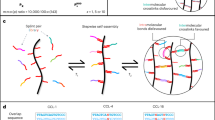Abstract
Polymeric matrices can be used to grow new tissues and organs1,2, and the delivery of growth factors from these matrices is one method to regenerate tissues3,4. A problem with engineering tissues that exist in a mechanically dynamic environment, such as bone, muscle and blood vessels5,6, is that most drug delivery systems have been designed to operate under static conditions. We thought that polymeric matrices, which release growth factors in response to mechanical signals, might provide a new approach to guide tissue formation in mechanically stressed environments. Critical design features for this type of system include the ability to undergo repeated deformation, and a reversible binding of the protein growth factors to polymeric matrices to allow for responses to repeated stimuli. Here we report a model delivery system that can respond to mechanical signalling and upregulate the release of a growth factor to promote blood vessel formation. This approach may find a number of applications, including regeneration and engineering of new tissues and more general drug-delivery applications.
This is a preview of subscription content, access via your institution
Access options
Subscribe to this journal
Receive 51 print issues and online access
$199.00 per year
only $3.90 per issue
Buy this article
- Purchase on Springer Link
- Instant access to full article PDF
Prices may be subject to local taxes which are calculated during checkout




Similar content being viewed by others
References
Langer, R. & Vacanti, J. P. Tissue engineering. Science 260, 920–926 ( 1993).
Putnam, A. J. & Mooney, D. J. Tissue engineering using synthetic extracellular matrices. Nature Med. 2, 824 –826 (1996).
Shea, L. D., Smiley, E., Bonadio, J. & Mooney, D. J. DNA delivery from polymer matrices for tissue engineering. Nature Biotechnol. 17, 551–554 ( 1999).
Ripamonti, U. & Reddi, A. H. Tissue engineering, morphogenesis, and regeneration of the periodontal tissues by bone morphogenetic proteins. Crit. Rev. Oral Biol. Med. 8, 154– 163 (1997).
Kim, B.-S., Nikolovski, J., Bonadio, J. & Mooney, D. J. Cyclic mechanical strain regulates the development of engineered smooth muscle tissue. Nature Biotechnol. 17, 979– 983 (1999).
Niklason, L. E. et al. Functional arteries grown in vitro. Science 284, 489–493 ( 1999).
Vlodavsky, I. et al. Extracellular sequestration and release of fibroblast growth factor: a regulatory mechanism? Trends Biochem. Sci. 16, 268–271 (1991).
Neufeld, G., Cohen, T., Gengrinovitch, S. & Poltorak, Z. Vascular endothelial growth factor (VEGF) and its receptors. FASEB J. 13, 9–22 ( 1999).
Baldwin, S. P. & Saltzman, W. M. Materials for protein delivery in tissue engineering. Adv. Drug Delivery Rev. 33, 71–86 (1998).
Jen, A. C., Wake, M. C. & Mikos, A. G. Hydrogels for cell immobilization. Biotechnol. Bioeng. 50, 357–364 ( 1996).
Plate, K. H., Breiser, G., Weich, H. A. & Risau, W. Vascular endothelial growth factor is a potential tumor angiogenesis factor in vivo. Nature 359, 845– 848 (1992).
Chicurel, M. E., Chen, C. S. & Ingber, D. E. Cellular control lies in the balance of forces. Curr. Opin. Cell Biol. 10, 232–239 (1998).
Williams, B. Mechanical influences on vascular smooth muscle cell function. J. Hypertension 16, 1921–1929 (1998).
Langer, R. Drug delivery and targeting. Nature 392 (suppl.), 5–10 (1998).
Wang, C., Stewart, R. J. & Kopecek, J. Hybrid hydrogels assembled from synthetic polymers and coiled-coil protein domains. Nature 397, 417–420 (1999).
Chen, G. & Hoffman, A. S. Graft copolymers that exhibit temperature-induced phase transition over a wide range of pH. Nature 373, 49–52 ( 1995).
Mitragorti, S., Blankschtein, D. & Langer, R. Ultrasound-mediated transdermal protein delivery. Science 269, 850–853 ( 1995).
Kwon, I. C., Bae, Y. H. & Kim, S. W. Electrically erodible polymer gel for controlled release of drugs. Nature 354, 291– 293 (1991).
Edelman, E., Brown, L. & Langer, R. In vitro and in vivo kinetics of regulated drug release from polymer matrices by oscillating magnetic fields. J. Biomed. Mater. Res. 21, 339–353 (1987).
Nör, J. E., Christensen, J., Mooney, D. J. & Polverini, P. J. Vascular endothelial growth factor (VEGF)-mediated angiogenesis is associated with enhanced endothelial cell survival and induction of BCL-2 expression. Am. J. Pathol. 152, 375– 384 (1999).
Acknowledgements
We thank the National Institutes of Health for financial support of this research. M.C.P. acknowledges the Whitaker Foundation for a graduate fellowship.
Author information
Authors and Affiliations
Corresponding author
Supplementary information
Rights and permissions
About this article
Cite this article
Lee, K., Peters, M., Anderson, K. et al. Controlled growth factor release from synthetic extracellular matrices . Nature 408, 998–1000 (2000). https://doi.org/10.1038/35050141
Received:
Accepted:
Issue Date:
DOI: https://doi.org/10.1038/35050141
This article is cited by
-
The advances in nanomedicine for bone and cartilage repair
Journal of Nanobiotechnology (2022)
-
Application of additively manufactured 3D scaffolds for bone cancer treatment: a review
Bio-Design and Manufacturing (2022)
-
Dynamic actuation enhances transport and extends therapeutic lifespan in an implantable drug delivery platform
Nature Communications (2022)
-
Skeletal muscle cell transplantation: models and methods
Journal of Muscle Research and Cell Motility (2020)
-
Strong dual-crosslinked hydrogels for ultrasound-triggered drug delivery
Nano Research (2019)
Comments
By submitting a comment you agree to abide by our Terms and Community Guidelines. If you find something abusive or that does not comply with our terms or guidelines please flag it as inappropriate.



